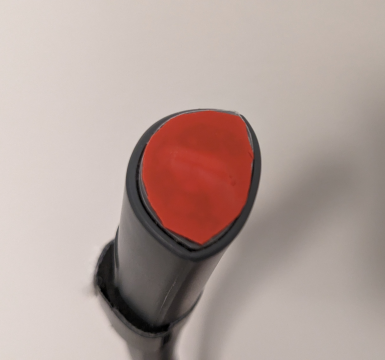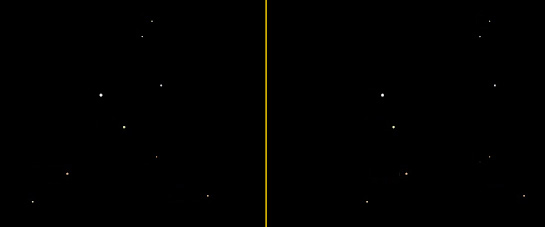Saturday, March 30, 2024
Who says blind people can't observe, too?
Tuesday, March 26, 2024
Eyepiece cheat codes: Determining directions in the telescope
Directions in the telescope can be confusing for beginners and even long time observers. It all depends on how many mirrors your telescope has. Generally, an odd number, and your telescope will mirror-reverse the view. An even number and your telescope will rotate the view 180 degrees.
A Newtonian reflector has two mirrors, the primary at the bottom of the tube and the secondary, the smaller one which directs the light to the eyepiece. In this case, an even number, therefore the view is rotated 180 degrees. (The view is rotated additionally because your focuser is usually located off to the side and your eye is positioned differently throughout the sky, so don’t assume south is always “up.”)
Most people with refractors and Cassegrain telescopes use a 90-degree mirror star diagonal before the eyepiece to give a more comfortable viewing position. That counts as one mirror in a refractor and three in a Cassegrain (which has a primary and secondary mirror plus the diagonal). An odd number, therefore these telescopes will keep the image correct side up, but mirror-reversed. (How your diagonal is rotated will affect what direction is actually "up" in your view.)
If you use an “erect image prism diagonal,” such as an Amici prism or pentaprism, in your refractor or Cassegrain, then you get a “correct image” that is neither rotated nor mirror-reversed (but there may be disadvantages that I won’t get into here).
One thing that stays the same regardless of your telescope type is that without any tracking motor engaged, the stars will always drift to the west (or, if you like, enter the field of view from the east). That’s because the Earth is rotating toward the east, and your telescope is fixed to the Earth. So you can always start with an easy reference point by noting the direction toward which the stars are drifting- that’s west. From there, you apply the correct diagram below and you are good to go!
If you’re interested in more information on how your equipment affects image orientation, see this article from the British Astronomical Association.
Choose the diagram that applies to your telescope
In all telescopes, stars and other objects will always drift to the WEST if the scope does not have a tracking motor operating. Know your telescope and directions in the eyepiece.
The diagrams below show an example of how position angle (PA) is used to indicate the direction from a primary star to its secondary companion (PA 225 in this example) in reflectors and refractors/Cassegrains (with diagonal). You can also give any directions in the sky using PA or compass direction (270 or west, for example), as in many of these Space Walks. This view would be facing south.
This is for a NEWTONIAN REFLECTOR, such as a Dobsonian, and also for a straight-through finderscope. These show the image rotated 180 degrees from what you would see just looking up or in binoculars. North is COUNTER-CLOCKWISE from West:
Tip: In Sky Safari Pro, tap the field of view measurement in the upper right and select "Flip: Both" so the chart will match your view in the eyepiece. Note that it might still be rotated somewhat because of your eye's orientation to the eyepiece.
REFRACTORS and CASSEGRAIN telescopes, typically used WITH A MIRROR DIAGONAL, will show the image correct side up but mirror reversed from what you would see just looking up or in binoculars. North is CLOCKWISE from West:
Tip: In Sky Safari Pro, tap the field of view measurement in the upper right and select "Flip: Horz" so the chart will match your view in the eyepiece.
Sunday, March 24, 2024
Added a new Space Walk Among the Stars - Binocular Edition
Give it a try while these are still placed well in the evening once it gets dark, around 9 p.m. EDT. The Moon should be out of the way at that time from about March 28 through April 9, 2024.
Monday, March 4, 2024
Lyra in 3D
3D Constellation post index and instructions
LYRA, The Lyre
The pattern we see.
The 3D version. Click for a larger image (for phones and small screens).
PARALLEL VIEW:
Tuesday, February 27, 2024
Cygnus in 3D
3D Constellation post index and instructions
CYGNUS, The Swan
The pattern we see.
The 3D version. Click for a larger image (for phones and small screens).
PARALLEL VIEW:
With labels:
CROSS VIEW:
With labels:
Data:
Sadr (γ) 2.2 1800
Deneb (α) 1.3 1400
Albireo (β) 3.1 430
δ 2.9 165
ζ 3.2 143
η 3.9 135
κ 3.8 124
ι² 3.8 121
Gienah (ε) 2.5 73
Sunday, February 25, 2024
Sagitta in 3D
3D Constellation post index and instructions
SAGITTA, The Arrow
The pattern we see.
The 3D version. Click for a larger image (for phones and small screens).
PARALLEL VIEW:
With labels:
CROSS VIEW:
With labels:
Data:
Object Magnitude Dist. (light yrs.)
Cepheus in 3D
3D Constellation post index and instructions
CEPHEUS, The King
The pattern we see.
The 3D version. Click for a larger image (for phones and small screens).
PARALLEL VIEW:
With labels:
CROSS VIEW:
With labels:
Data:
Object Magnitude Dist. (light yrs.)
Saturday, February 24, 2024
Cassiopeia in 3D
3D Constellation post index and instructions
CASSIOPEIA, The Queen
Friday, February 23, 2024
Perseus in 3D
3D Constellation post index and instructions
PERSEUS, The Hero
The pattern we see.
The 3D version. Click for a larger image (for phones and small screens).
PARALLEL VIEW:
With labels:
CROSS VIEW:
With labels:
Data:
Object Magnitude Dist. (light yrs.)
Aries in 3D
3D Constellation post index and instructions
ARIES, The Ram
The pattern we see.
The 3D version. Click for a larger image (for phones and small screens).
PARALLEL VIEW:
With labels:
CROSS VIEW:
With labels:
Data:
Object Magnitude Dist. (light yrs.)
Thursday, February 22, 2024
How to modify a white light neck light for astronomy use
Don’t be that guy. The one with the red headlamp who thinks he’s got this covered. No white lights on the observing field, right? Wrong. Even really dim red headlamps, which are rare, will zap your fellow observers in the eyes as soon as you look at them. Which you will do. Then there goes the night vision. And your invitation back.
Don’t get me wrong, I love headlamps because they keep my hands free. But I’ve learned that wearing them around others is inconsiderate. Because I will zap them in the eyes. It’s our natural tendency to look at others when we talk to them.
There are some nice hand held red LED flashlights- the Rigel Systems 2-LED red or mini, for example- but often you need both hands free.
So what’s an astronomer to do?
My current solution is to take a white LED neck light and cover one or both of the lenses with red taillight lens tape [or red nail polish]. I picked up a Glocusent upgraded neck light and modified it for astronomy use this way.
 |
| Glocusent upgraded version. Older version is a bit thicker and has separate on/off for each light. |
 |
| The modification keeps the white light for when needed. |
Like headlamps, neck lights keep your hands free, but they aim downward and not into other people’s eyes. Perfect for working on stuff or searching the ground for the filter you dropped in the dewy grass. They have flexible arms that can be positioned as needed. The only problem is that currently almost all of them are white LEDs. I found one with a red LED, but I figured I’d rather get other features I want and just filter the lenses myself. [8/24/24 update: The only downside of the neck light I have found so far is that if you are bending over toward the ground, the light kind of just hangs loosely from you neck and you'll have to guide the light where you need it with your hand. To remedy this, you can tuck one side under your outer layer of clothing at the neck, which anchors it well.]
Neck lights have two lights, but some are controlled separately. I opted for one with a single on/off button since it would be easier at night. The Glocusent has three different color temperature settings and three brightness levels, with buttons on the opposite arm. Many lights have similar features.
Look for a model that has a flat light surface so it will be easy to tape it up. I used one layer of red taillight tape, and with the color temp and brightness settings, I have all the range I need. [8/24/24 update: The tape didn't stick too well after a while, so I just painted a couple coats of red nail polish on the lens and it's just like having the tape, but I know it won't fall off.] In addition, I just capped off the other side to keep it a white light for when I need it. The caps are a tight friction fit.
 |
| Nice flat surface for the tape. |
 |
| Tape in place. |
I cut the caps from a 1/8 inch black craft foam sheet, then rolled and wrapped them with Gorilla (duct) tape. They slip on tightly and conform to the odd shape of the light housings. Note the pieces of fuzzy Velcro I put on buttons to provide tactile cues in the dark. Pretty simple.
 |
| Open cover for the red side. |
 |
| Closed cover for the white side. |
The caps also provide a recess for the lights, which further prevents the actual LED from shining in someone’s eyes and narrows the beam to a spot. Without the caps, the LEDs are visible even when hanging down around your neck and they have a pretty wide “flood” style beam.
 |
| This is what your friend sees. |
 |
| This is what you see. It can get much dimmer. |
That’s it. These things go for around $20-25, they have rechargeable lithium-ion batteries, and will probably last as long as you would expect for the price. Great addition to your observing kit, and your fellow observers will thank you. (Also makes a great reading light- who would have thought?)













































